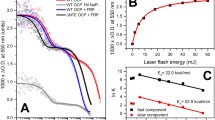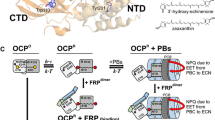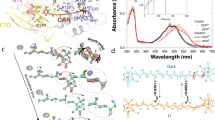Abstract
Orange carotenoid protein (OCP) is a water-soluble photoactive protein responsible for a photoprotective mechanism of nonphotochemical quenching in cyanobacteria. Under blue–green illumination, OCP converts from the stable orange into the signaling red quenching form; however, the latter form could also be obtained by chemical activation with high concentrations of sodium thiocyanate (NaSCN) or point mutations. In this work, we show that a single replacement of tryptophan-288, normally involved in protein-chromophore interactions, by alanine, results in formation of a new protein form, hereinafter referred to as purple carotenoid protein (PCP). Comparison of resonance Raman spectra of the native photoactivated red form, chemically activated OCP, and PCP reveals that carotenoid conformation is sensitive to the structure of the C-domain, implicating that the chromophore retains some interactions with this part of the protein in the active red form. Combination of differential scanning fluorimetry and picosecond time-resolved fluorescence anisotropy measurements allowed us to compare the stability of different OCP forms and to estimate relative differences in protein rotation rates. These results were corroborated by hydrodynamic analysis of proteins by dynamic light scattering and analytical size-exclusion chromatography, indicating that the light-induced conversion of the protein is accompanied by a significant increase in its size. On the whole, our data support the idea that the red form of OCP is a molten globule-like protein in which, however, interactions between the carotenoid and the C-terminal domain are preserved.





Similar content being viewed by others
Abbreviations
- OCPO :
-
Orange carotenoid protein—orange form
- OCPR :
-
Orange carotenoid protein—red form
- PCP:
-
Purple Carotenoid Protein (W288A-OCP)
- RCP:
-
Red Carotenoid Protein
- ECN:
-
Echinenone
- NPQ:
-
Non-photochemical quenching
- τ :
-
Fluorescence lifetime
- φ fl :
-
Fluorescence quantum yield
- r :
-
Anisotropy
- θ :
-
Correlation time
- NR:
-
Nile red
- SEC:
-
Size-exclusion chromatography
- DSF:
-
Differential scanning fluorimetry
- DLS:
-
Dynamic light scattering
- HOOP:
-
Hydrogen-out-of-plane
References
Bartalucci G, Coppin J, Fisher S, Hall G, Helliwell JR, Helliwell M, Liaaen-Jensen S (2007) Unravelling the chemical basis of the bathochromic shift in the lobster carapace; new crystal structures of unbound astaxanthin, canthaxanthin and zeaxanthin. Acta Crystallogr B 63:328–337. doi:10.1107/S0108768106052633
Berera R, van Stokkum IH, Gwizdala M, Wilson A, Kirilovsky D, van Grondelle R (2012) The photophysics of the orange carotenoid protein, a light-powered molecular switch. J Phys Chem B 116:2568–2574. doi:10.1021/jp2108329
Boulay C, Abasova L, Six C, Vass I, Kirilovsky D (2008) Occurrence and function of the orange carotenoid protein in photoprotective mechanisms in various cyanobacteria. Biochim Biophys Acta 1777:1344–1354. doi:10.1016/j.bbabio.2008.07.002
Breitenbach J, Gerjets T, Sandmann G (2013) Catalytic properties and reaction mechanism of the CrtO carotenoid ketolase from the cyanobacterium Synechocystis sp. PCC 6803. Arch Biochem Biophys 529:86–91
Chabera P, Durchan M, Shih PM, Kerfeld CA, Polivka T (2011) Excited-state properties of the 16 kDa red carotenoid protein from Arthrospira maxima. Biochim Biophys Acta 1807:30–35. doi:10.1016/j.bbabio.2010.08.013
Chergui M et al (2013) Comparing the photophysics of the two forms of the Orange carotenoid protein using 2D electronic spectroscopy. EPJ Web of Conferences 41:08008. doi:10.1051/epjconf/20134108008
Chib R, Raut S, Sabnis S, Singhal P, Gryczynski Z, Gryczynski I (2014) Associated anisotropy decays of ethidium bromide interacting with DNA. Methods Appl Fluoresc 2(1):015003. doi:10.1088/2050-6120/2/1/015003
Cianci M, Rizkallah PJ, Olczak A, Raftery J, Chayen NE, Zagalsky PF, Helliwell JR (2002) The molecular basis of the coloration mechanism in lobster shell: beta-crustacyanin at 3.2-A resolution. Proc Natl Acad Sci USA 99:9795–9800. doi:10.1073/pnas.152088999
de Carbon CB, Thurotte A, Wilson A, Perreau F, Kirilovsky D (2015) Biosynthesis of soluble carotenoid holoproteins in Escherichia coli. Sci Rep 5:9085. doi:10.1038/srep09085
Demmig-Adams B, Adams WW (1996) The role of xanthophyll cycle carotenoids in the protection of photosynthesis. Trends Plant Sci 1:21–26
Denison FC, Gökirmak T, Ferl RJ (2014) Phosphorylation-related modification at the dimer interface of 14-3-3ω dramatically alters monomer interaction dynamics. Arch Biochem Biophys 541:1–12
Fernández-González B, Sandmann G, Vioque A (1997) A new type of asymmetrically acting β-carotene ketolase is required for the synthesis of echinenone in the cyanobacterium Synechocystis sp. PCC 6803. J Biol Chem 272:9728–9733
Flora K, Brennan JD, Baker GA, Doody MA, Bright FV (1998) Unfolding of acrylodan-labeled human serum albumin probed by steady-state and time-resolved fluorescence methods. Biophys J 75:1084–1096
Frank HA, Cogdell RJ (1996) Carotenoids in Photosynthesis. Photochem Photobiol 63:257–264. doi:10.1111/j.1751-1097.1996.tb03022.x
Graf M, Bojak A, Deml L, Bieler K, Wolf H, Wagner R (2000) Concerted action of multiple cis-acting sequences is required for Rev dependence of late human immunodeficiency virus type 1 gene expression. J Virol 74:10822–10826
Gupta S et al (2015) Local and global structural drivers for the photoactivation of the orange carotenoid protein. Proc Natl Acad Sci USA 112:E5567–E5574. doi:10.1073/pnas.1512240112
King JD, Liu H, He G, Orf GS, Blankenship RE (2014) Chemical activation of the cyanobacterial orange carotenoid protein. FEBS Lett 588:4561–4565. doi:10.1016/j.febslet.2014.10.024
Kirilovsky D, Kerfeld CA (2013) The Orange Carotenoid Protein: a blue-green light photoactive protein. Photochem Photobiol Sci 12:1135–1143. doi:10.1039/c3pp25406b
Kish E, Pinto MM, Kirilovsky D, Spezia R, Robert B (2015) Echinenone vibrational properties: from solvents to the orange carotenoid protein. Biochim Biophys Acta 1847:1044–1054. doi:10.1016/j.bbabio.2015.05.010
Lakowicz JR (2013) Principles of fluorescence spectroscopy. Springer, Berlin
Leverenz RL, Jallet D, Li MD, Mathies RA, Kirilovsky D, Kerfeld CA (2014) Structural and functional modularity of the orange carotenoid protein: distinct roles for the N- and C-terminal domains in cyanobacterial photoprotection. Plant Cell 26:426–437. doi:10.1105/tpc.113.118588
Leverenz RL et al (2015) A 12 Å carotenoid translocation in a photoswitch associated with cyanobacterial photoprotection. Science 348:3
Liu WL, Wang ZG, Zheng ZR, Li AH, Su WH (2008) Effect of β-ring rotation on the structures and vibrational spectra of β-carotene: density functional theory analysis. J Phys Chem A 112(42):10580–10585
Liu H, Zhang H, Niedzwiedzki DM, Prado M, He G, Gross ML, Blankenship RE (2013) Phycobilisomes supply excitations to both photosystems in a megacomplex in cyanobacteria. Science 342:1104–1107
Liu H, Zhang H, King JD, Wolf NR, Prado M, Gross ML, Blankenship RE (2014) Mass spectrometry footprinting reveals the structural rearrangements of cyanobacterial orange carotenoid protein upon light activation. Biochim Biophys Acta 1837:1955–1963. doi:10.1016/j.bbabio.2014.09.004
Liu H et al (2016) Dramatic Domain Rearrangements of the Cyanobacterial Orange Carotenoid Protein upon Photoactivation. Biochemistry 55:1003–1009. doi:10.1021/acs.biochem.6b00013
Maksimov EG et al (2014) The time course of non-photochemical quenching in phycobilisomes of Synechocystis sp. PCC6803 as revealed by picosecond time-resolved fluorimetry. Biochim Biophys Acta 1837:1540–1547. doi:10.1016/j.bbabio.2014.01.010
Maksimov EG et al (2015) The Signaling State of Orange Carotenoid Protein. Biophys J 109:595–607. doi:10.1016/j.bpj.2015.06.052
Misawa N et al (1995) Structure and functional analysis of a marine bacterial carotenoid biosynthesis gene cluster and astaxanthin biosynthetic pathway proposed at the gene level. J Bacteriol 177:6575–6584
Niesen FH, Berglund H, Vedadi M (2007) The use of differential scanning fluorimetry to detect ligand interactions that promote protein stability. Nat Protoc 2(9):2212–2221. doi:10.1038/nprot.2007.321
Pascal AA et al (2005) Molecular basis of photoprotection and control of photosynthetic light-harvesting. Nature 436:134–137
Polívka T, Kerfeld CA, Pascher T, Sundström V (2005) Spectroscopic Properties of the Carotenoid 3‘-Hydroxyechinenone in the orange carotenoid protein from the Cyanobacterium Arthrospira maxima. Biochemistry 44:3994–4003. doi:10.1021/bi047473t
Salares V, Young N, Bernstein H, Carey P (1979) Mechanisms of spectral shifts in lobster carotenoproteins The resonance raman spectra of ovoverdin and the crustacyanins. Biochim Biophys Acta (BBA) Protein Struct 576:176–191
Shakhnovich EI, Finkelstein AV (1989) Theory of cooperative transitions in protein molecules. I. Why denaturation of globular protein is a first-order phase transition. Biopolymers 28:1667–1680. doi:10.1002/bip.360281003
Stadnichuk IN, Yanyushin MF, Maksimov EG, Lukashev EP, Zharmukhamedov SK, Elanskaya IV, Paschenko VZ (2012) Site of non-photochemical quenching of the phycobilisome by orange carotenoid protein in the cyanobacterium Synechocystis sp. PCC 6803. Biochim Biophys Acta 1817:1436–1445. doi:10.1016/j.bbabio.2012.03.023
Stadnichuk IN et al (2013) Fluorescence quenching of the phycobilisome terminal emitter LCM from the cyanobacterium Synechocystis sp. PCC 6803 detected in vivo and in vitro. J Photochem Photobiol B 125:137–145. doi:10.1016/j.jphotobiol.2013.05.014
Wilson A et al (2010) Structural determinants underlying photoprotection in the photoactive orange carotenoid protein of cyanobacteria. J Biol Chem 285:18364–18375. doi:10.1074/jbc.M110.115709
Wilson A, Punginelli C, Couturier M, Perreau F, Kirilovsky D (2011) Essential role of two tyrosines and two tryptophans on the photoprotection activity of the Orange Carotenoid Protein. Biochim Biophys Acta 1807:293–301. doi:10.1016/j.bbabio.2010.12.009
Wilson A, Gwizdala M, Mezzetti A, Alexandre M, Kerfeld CA, Kirilovsky D (2012) The essential role of the N-terminal domain of the orange carotenoid protein in cyanobacterial photoprotection: importance of a positive charge for phycobilisome binding. Plant Cell 24:1972–1983. doi:10.1105/tpc.112.096909
Yguerabide J, Epstein HF, Stryer L (1970) Segmental flexibility in an antibody molecule. J Mol Biol 51:573–590
Zhang H, Liu H, Niedzwiedzki DM, Prado M, Jiang J, Gross ML, Blankenship RE (2014) Molecular mechanism of photoactivation and structural location of the cyanobacterial orange carotenoid protein. Biochemistry 53:13–19. doi:10.1021/bi401539w
Acknowledgments
V.Z.P. and E.G.M. thank the Russian Foundation for Basic Research (Projects Nos. 14-04-01536A and 15-04-01930A) for partial support of this work. E.A.S. and E.G.M. thank the Russian Scientific Foundation (Project 14-17-00451) for partial support of this work. E.G.M., G.V.T., and K.E.K. thank the Russian Ministry of Education and Science (Project MK-5949.2015.4) for partial support of this work. This work was supported, in part by a Dynasty Foundation Fellowship to E.G.M. The reported study was funded by RFBR and Moscow city Government according to the research Project No. 15-34-70007 «mol_a_mos» . T.F., F.-J.S, N.N.T., M.W., and M.M gratefully acknowledge support from the Stifterverband für die Deutsche Wissenschaft (Study reform Project “OPLChem”) and the German Research Foundation (DFG, Cluster of Excellence “Unifying Concepts in Catalysis”).
Author information
Authors and Affiliations
Corresponding author
Rights and permissions
About this article
Cite this article
Maksimov, E.G., Moldenhauer, M., Shirshin, E.A. et al. A comparative study of three signaling forms of the orange carotenoid protein. Photosynth Res 130, 389–401 (2016). https://doi.org/10.1007/s11120-016-0272-8
Received:
Accepted:
Published:
Issue Date:
DOI: https://doi.org/10.1007/s11120-016-0272-8




